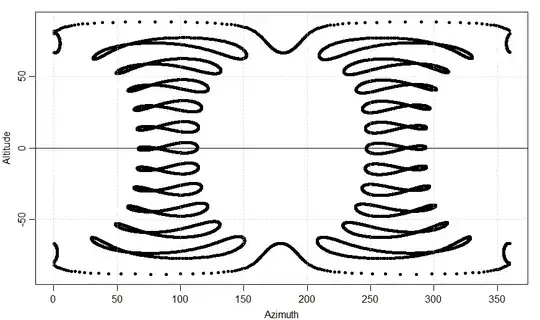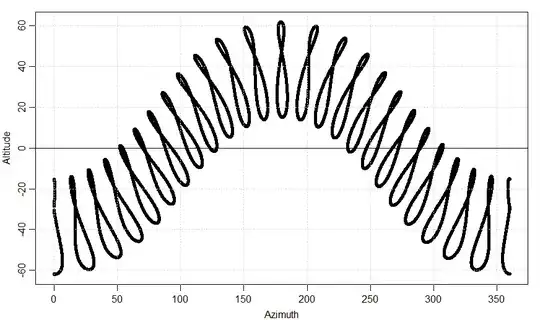I'm finding several sources on the internet which say that the solar analemma at the equator is a horizontal line, but this makes no sense to me, especially the analemma at noon, for which the sun should surely travel vertically from the tropic of cancer to the tropic of capricorn and back (and probably with some some lateral displacement as well.)
I'm expecting that the dawn and dusk analemmas are far closer to horizontal, but there should still be some shape to them -- a simple line does not seem likely. The best answer from my point of view would show/describe 15 analemmas, representing the sun's positions through the year as seen from both tropics and from the equator, and pinpointing the locations at 7am, 9:30am, noon, 2:30 pm, and 5 pm.
An extension of this question (Please note: I will use the singular form “analemma” because it seems easier to understand, though “analemmas” would be more correct: it is not a single object but a set of human constructs plotted over time and space.)
Thanks all for your comments on the original question. Most seem to favor the horizontal orientation, either a simple east-west line or a horizontally oriented infinity sign, an eight lying on its side. My sense is that these images may not be grounded in empirical observations of how the analemma (or its shadow on the ground) actually appears in the equatorial zone, but instead derive from thinking about why the analemma appears as a bottom-heavy figure eight in the northern hemisphere, compared to a top-heavy eight in the southern hemisphere.
If anyone is aware of scientific observations that confirm the idea of an east-west orientation at the equator, please let me/us know. Otherwise, I'd like to share an alternative answer which I find more believable. Of course, my answer too is merely based on pondering why the analemma is reversed in the southern skies – I have no experimental observations of my own.
I don’t see how these “horizontalization” solutions could work. They beg the question: At what point does the analemma’s northern hemisphere verticality flip to being horizontal, and at what point does this equatorial horizontality flip to the southern version – and of course, vice versa? Most astronomical movements progress very slowly; unless we can visualize a slow and steady transformation between these different orientations as observer viewpoints change, I don’t think such solutions can be correct.
The description of the southern hemisphere analemma as being an inversion of the one we see in the north is clearly true. Viewed from the north, the smaller sector of the figure eight appears above the larger one, and in the southern hemisphere the smaller sector is lower down in the sky, and the larger one points upwards. It does indeed sound as though the shape in the sky must have reversed above the equator – but can that in fact be the case?
I want to suggest a different scenario for the transition from north to south. For simplicity I will only consider the analemma as plotted at solar noon, and will also focus on its vertical dimension, with very little to say about the width of its eight-like appearance except to acknowledge that this is divided into uneven sectors. Other lateral aspects of the shape are complex and do not seem needed for the discussion.
Imagine observers travelling longitudinally from north to south, the analemma is a vertical (almost) figure of eight with its larger sector lower in the southern sky. As they approach the tropic of Cancer, that analemma would remain vertical and move higher in the sky, until the tip of the smaller, upper loop – the summer solstice point – is directly overhead. As they progress further, into the equatorial zone, would they not expect to see that point move overhead behind them and the bottom of the larger, lower loop continue to rise? And when they reach the equator and then cross the tropic of Capricorn, the lower loop’s tip – the winter solstice point – would also pass directly overhead and begin to descend behind them. To see the analemma they would need to look up or lie on their backs and view the sky above their heads, in which case the larger loop would still appear to be below and the smaller loop (associated with the tropic Cancer and the summer solstice) would be higher -- at least with reference to their supine bodies.
But of course, they could remain standing and simply turn around, in which case their picture changes: the larger loop would now be higher in the (northern) sky and the smaller loop would be lower. But this change is caused by the observers’ about turn, and is no reason for thinking that the analemma has drastically changed in the equatorial zone. The larger loop continues to be the southern section of the analemma, but because it is now being viewed from the south it appears higher in the sky – and the smaller section of the loop, viewed from the south, appears lower because it represents the sun at points further north. (Turning around in this way also has other effects – for example, suddenly they perceive the sun as moving across the sky from right to left – though this is still east to west, of course.)
I hope this account paints a clear picture for you of my reasons for thinking the idea of horizontal analemma in the tropics is incorrect. Instead it should maintain its north-south orientation -- its apparent reversal in the southern sky is simply due to the fact that we are seeing it from a different perspective: down under. It is we who have turned around, not the analemma.
Extension #2 An attempted summary (Please note: Here I’ll lay out what I have gathered from the comments and answers posted on my original question. Though it’s a summary, it remains part of the question rather than an “Answer”, because I’d appreciate further feedback if people think the summary still contains mistaken ideas – or confirmation if you think that it is now essentially correct. Plus, I have additional analemma questions I would like to explore, and intend to post as separate questions later)
I see now that my original question, about internet sources stating that solar analemmas have a horizontal orientation if plotted at the equator, was misguided because I didn’t understand the way astronomers use the terms horizontal and vertical. By my (wrong) interpretation, the sources were saying that analemmas at the equator essentially underwent a radical change, switching from a north-south (“vertical”) orientation to an east-west (“horizontal”) direction. This idea was totally counter to my expectation, which was that they would remain north-south pointing from any location on the earth’s surface, not only in the temperate zones.
But of course, when discussing the sky as seen from a given point, astronomers determine celestial locations in terms of azimuth (degrees of horizontal separation as measured along the horizon from the first Aries point – the position of the dawn sun at the vernal equinox) and elevation (degrees of vertical separation from the horizon toward the overhead apex). Thus, a shape like an analemma is considered horizontal in whatever quarter of the sky it appears, so long as the two loops (or tips) are at the same elevation from the horizon. This of course includes north-south analemmas, which are horizontal if they are due east or due west of an observation point on the equator.
As it happens, to focus my question I selected the one type of analemma – the noon analemma – which, at the equator, centers on the actual apex of the sky, where it cannot be described as horizontal. Most equatorial analemmas, however, are based on the morning or the afternoon hours, and would be distributed along the celestial equator, where they would present more as infinity signs than figure eights. The observer would need look toward the east or the west to plot the sun’s positions for these analemmas.
Thus, the description of off-noon equatorial analemmas as horizontal infinity signs clearly does not contradict my expectation that their long dimension extends north-to-south (or vice versa) – rather, it confirms it. And an additional unstated expectation, that the morning-hour infinity-shaped analemmas will display their smaller loop to the right (pointing south) and that afternoon analemmas will show it on the left (also pointing south) remains plausible to me. I hope other readers will agree that this seems correct – or explain why.
There are other related quesiona that I would like to explore with respect to solar analemmas on earth, relating to the orientation of off-noon analemmas in the temperate zones of earth, and also the tip-to-tip length of analemmas at different latitudes. (Does this vary?) I plan to post these questions in the next week or two, and would greatly appreciate any feedback on them, especially from some of the contributors to this present chain of discussion, who have been very helpful!



verbosemode in my program). – PM 2Ring Feb 01 '24 at 18:09